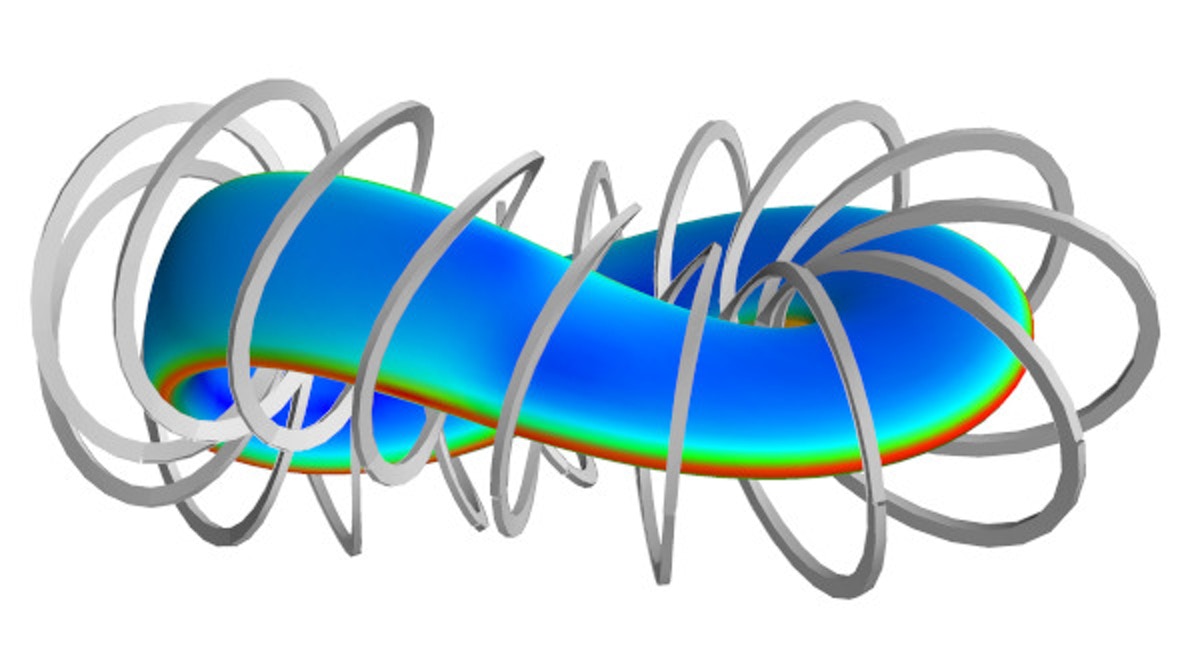Summary
Stellarators are non-axisymmetric magnetic field configurations for confinement of fusion plasmas. In contrast to the more popular axisymmetric tokamak geometries, stellarators rely on symmetry breaking to confine particles. We are pleased to be part of the the Simons Collaboration on Hidden Symmetries and Fusion Energy, a team dedicated to advancing the mathematical and computational state of the art in stellarator design and producing a modern stellarator optimization code that can exploit the full power of petascale and exascale computers. With expertise spanning optimization theory, plasma physics, dynamical systems, and PDE analysis, our collaboration model is based on shared postdocs – if this sounds like it might be exciting to you, we are looking!
Papers
(missing reference)@article{2023-jpp,
author = {Bindel, David and Landreman, Matt and Padidar, Misha},
title = {Understanding Trade-offs in Stellarator Design with Multi-objective Optimization},
journal = {Journal of Plasma Physics},
volume = {85},
number = {5},
pages = {905890503},
year = {2023},
arxiv = {2304.08698},
doi = {10.1017/S0022377823000788}
}
Abstract:
In designing stellarators, any design decision ultimately comes with a trade-off. Improvements in particle confinement, for instance, may increase the burden on engineers to build more complex coils, and the tightening of financial constraints may simplify the design and worsen some aspects of transport. Understanding trade-offs in stellarator designs is critical in designing high performance devices that satisfy the multitude of physical, engineering, and financial criteria. In this study we show how multi-objective optimization (MOO) can be used to investigate trade-offs and develop insight into the role of design parameters. We discuss the basics of MOO, as well as practical solution methods for solving MOO problems. We apply these methods to bring insight into the selection of two common design parameters: the aspect ratio of an ideal magnetohydrodynamic equilibrium, and the total length of the electromagnetic coils.
@article{2023-ppcf,
author = {Bindel, David and Landreman, Matt and Padidar, Misha},
title = {Direct Optimization of Fast-Ion Confinement in Stellarators},
journal = {Plasma Physics and Controlled Fusion},
volume = {65},
pages = {065012},
year = {2023},
arxiv = {2302.11369},
doi = {10.1088/1361-6587/acd141}
}
Abstract:
Confining energetic ions such as alpha particles is a prime concern in the design of stellarators. However, directly measuring alpha confinement through numerical simulation of guiding-center trajectories has been considered to be too computationally expensive and noisy to include in the design loop, and instead has been most often used only as a tool to assess stellarator designs post hoc. In its place, proxy metrics, simplified measures of confinement, have often been used to design configurations because they are computationally more tractable and have been shown to be effective. Despite the success of proxies, it is unclear what is being sacrificed by using them to design the device rather than relying on direct trajectory calculations. In this study, we optimize stellarator designs for improved alpha particle confinement without the use of proxy metrics. In particular, we numerically optimize an objective function that measures alpha particle losses by simulating alpha particle trajectories. While this method is computationally expensive, we find that it can be used successfully to generate configurations with low losses.
Talks
Linear Algebra, Invariant Circles, and Fusion Plasmas
BIRS Workshop on New Directions in Applied Linear Algebra
stellarator
•
meeting external invited
Global Stochastic Optimization of Stellarator Coils
SIAM Computational Science and Engineering 2023, Amsterdam
stellarator
•
meeting minisymposium external invited
Optimizing Magnetic Confinement Devices for Fusion Plasmas
Cornell SCAN Seminar
stellarator
•
seminar local
Constrained, Multi-Objective, and Parameterized Optimization
Simons Collaboration Meeting, Institute for Plasma Physics, Greifswald, Germany
stellarator
•
meeting external invited
Surrogate-Based Optimization of Stellarators
SIAM Computational Science and Engineering 2021, online
stellarator globalopt gp kernel
•
meeting minisymposium external invited
Surrogate Methods for Optimizing Fusion Device Designs
SIAM Analysis of PDEs 2019, La Quinta
stellarator globalopt gp kernel
•
minisymposium external invited
Global, Robust, Multi-Objective Optimization of Stellarators
Simons Collaboration on Hidden Symmetries and Fusion Energy Annual Meeting
stellarator
•
external invited
Multi-Objective Stochastic Optimization of Magnetic Fields
Simons Foundation Proposal Presentation
stellarator
•
external invited
